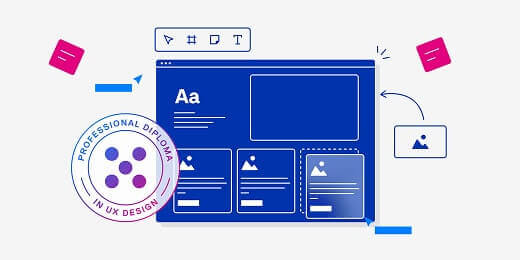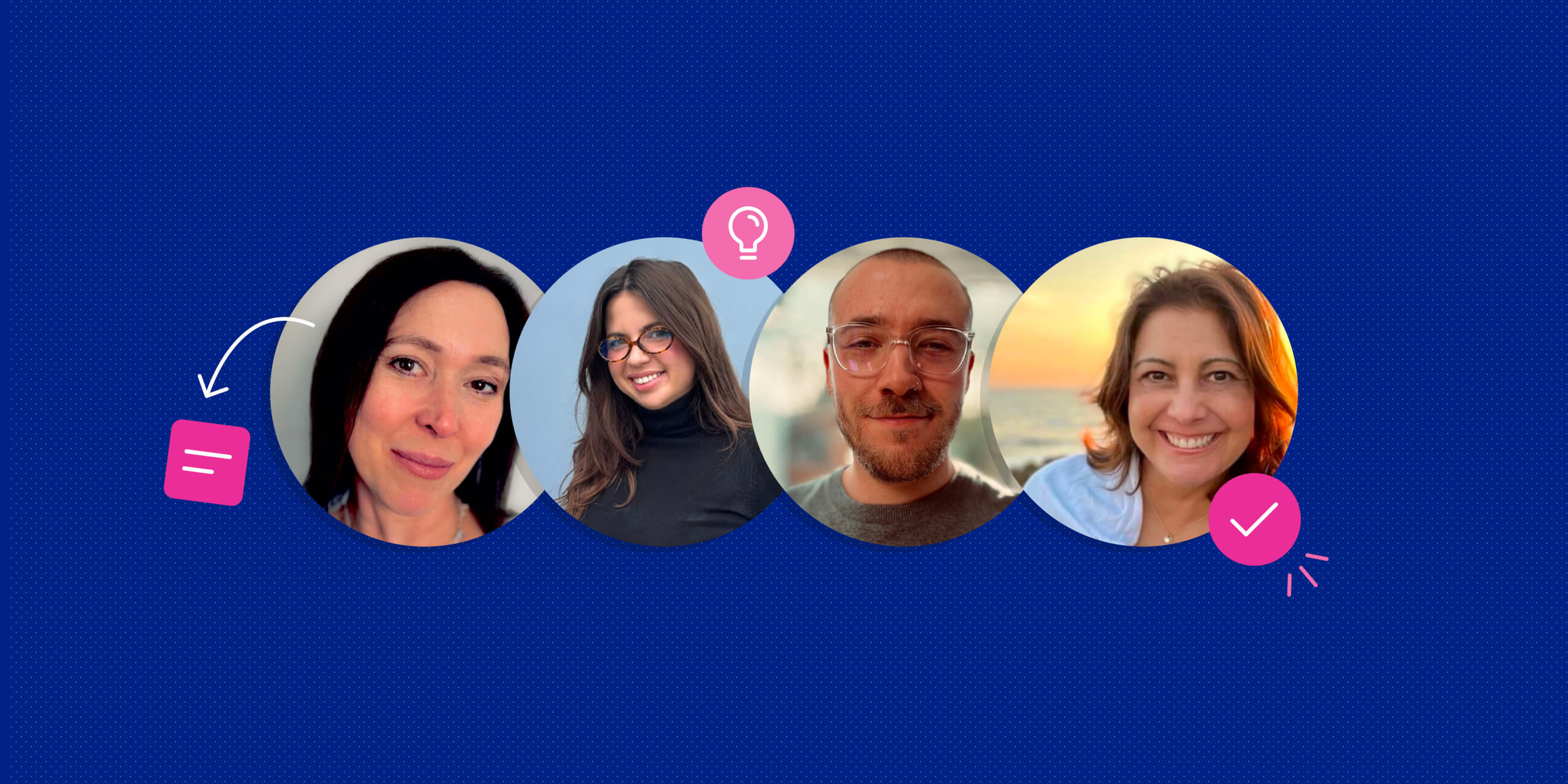If you’re thinking about switching from architecture to UX, you’ll be pleased to know that the two have many similarities.
Both architecture and UX design focus on creative, user-centric problem-solving, and they leverage many of the same skills. But they also have their differences—especially when it comes to salary, demand, and overall job satisfaction.
So what does it take to move from architecture to UX? And what can you expect from this new career path?
We’ll cover everything you need to know in this guide, complete with practical tips to set your career change in motion.
What drives architects to rethink their career path?
Architecture has long been a popular career choice for those who want to blend creativity and technical expertise, solve complex challenges, and have a tangible impact on the physical environment.
For many, a career in architecture promises variety, fulfilment, and a certain degree of prestige. But, after years of studying and training, the reality of the industry can fall short of expectations.
According to ongoing survey data gathered by CareerExplorer, architects rate their overall career happiness as just 3.1 out of 5 stars—putting them in the bottom 41% of careers for job satisfaction.
Here are some of the main challenges architects face, and the key factors that drive many architects to rethink their career choices.
Long hours and (often unpaid) overtime
Architecture can be a demanding field with tight deadlines and heavy workloads, and it’s not uncommon for architects to work long hours and overtime.
According to a report by FRAME Recruitment, overtime has long been ‘a way of life’ within the architecture industry. From 2022 to 2024, the number of architects reporting to work 1-3 hours of overtime per week increased from 28% to 36%.
While longer periods of overtime seem to have decreased (8% of respondents worked 7-9 hours of overtime per week in 2024, down from 13% in 2022), there continues to be an issue around employer expectations and work-life balance.
And, in the same report, 79% of respondents said that overtime at their practice is unpaid, with a further 12% reporting that rules around paid overtime are inconsistent.
For many in the industry, this takes a toll both financially and emotionally—and it can lead to a strong sense of resentment for the job.
Low pay
In comparison to other professions requiring a similar level of education, training, and responsibility, architects are often underpaid—and they’re not very happy about it.
In a survey carried out by Bespoke Careers, 60% of architects in the UK reported that they are dissatisfied or very dissatisfied with their pay. Data gathered by CareerExplorer paints a similar picture, with architects rating their salary satisfaction as just 2.7 out of 5.
FRAME Recruitment’s Architecture Salary Survey and Employment Report 2024 echoes this sentiment, with 93% of survey respondents expressing concerns that salaries in the architecture industry are not keeping up with the cost of living.
One respondent, an Architectural Technologist in the residential sector, describes the situation as follows:
“Architecture salaries are already ridiculously low, especially when you consider the overtime and amount of training it takes. People are moving jobs all the time to chase better pay, benefits and work-life balance, but many are leaving the industry altogether because it is just too stressful and not worth it or even enjoyable anymore.”
High stress and a lack of work-life balance
Architects can face huge pressure to deliver complex projects within tight deadlines and budget constraints. For many, the nature of the job coupled with long hours, overtime, and a lack of work-life balance results in stress and burnout.
At the same time, only 28% of Bespoke Careers’ survey respondents felt that their employer was taking care of their wellbeing.
Unfulfilling work and a sense of stagnation
When asked how meaningful they find their work to be, architects gave an average rating of just 2.9 out of 5.
Possible reasons for this include a lack of agility in the industry, a tendency to rely on outdated tools and processes, and difficulty in getting promoted or finding opportunities to grow and progress.
While the architecture industry is expected to grow 5% between 2022 and 2032, it’s not quite keeping pace with the tech industry. By comparison, the employment rate for web developers and digital designers is projected to increase by 8% between 2023 and 2033. As such, architects are increasingly looking to other fields for more, and better, career opportunities.
For many architects, the demands and realities of the profession outweigh the positives—prompting them to seek alternative career paths with greater balance, fulfilment, and growth.
Why consider a new career in UX?
For architects who want to leverage their creative, problem-solving, and technical skills to carve out a more rewarding career path, the UX industry has lots to offer.
Here are just some of the many reasons to consider a career in UX.
The demand for UX skills is growing
If you’re thinking about transitioning to a career in UX, you may have concerns about demand and job security. Fortunately, the future looks bright for UX professionals—making this a great time to join the industry.
If in doubt, consider the following statistics:
- UX and design skills are among the top 10 skills that businesses will prioritise globally in the coming years (World Economic Forum’s Future of Jobs report).
- 68% of UX hiring managers expect demand for UX skills to increase at their company in the next 1-2 years (UX Design Institute’s survey of over 500 UX professionals).
- Employment of web developers and digital / UX designers is projected to grow faster than the average for all occupations (U.S. Bureau of Labor Statistics).
Despite concerns that the UX job market is oversaturated, the demand for UX skills continues to increase—driven by steady and continuous growth in the tech industry, together with large-scale digital transformation in sectors like finance, government, and medical tech.
UX salaries are competitive
For many architects, low pay is a major source of frustration. By comparison, the UX industry is known for its competitive pay, with salaries typically landing above the national average.
CareerExplorer reports that the majority of UX designers are happy with their salaries. UX scores an average of 3.5 out of 5 for salary satisfaction—considerably higher than the average of 2.7 out of 5 for architects.
If you’re curious to see exactly how much you could earn as a UX designer, refer to our UX designer salary guide which features all the latest salary data for various locations and experience levels.
UX designers report above-average levels of career satisfaction
While architects are in the bottom 41% of all careers when it comes to career satisfaction, UX designers are in the top 30% for career happiness.
In a survey of over 500 UX professionals conducted by the UX Design Institute, an impressive 92% of respondents said that they are satisfied with their careers.
With the opportunity to solve real problems with your designs, change people’s lives for the better, and shape the next generation of technology, the UX industry offers great potential for meaningful, fulfilling work—not to mention variety. No wonder UX designers are pretty happy overall!
Working in UX offers great flexibility
As an architect, you may find yourself tied to specific locations—be that the office or a project site. This can make it difficult to work flexibly and achieve a good work-life balance, especially when you add long hours and overtime into the mix.
By contrast, a career in UX can offer great flexibility. It’s increasingly common for UX teams to work remotely—and, thanks to virtual tools like Figma and Miro, this doesn’t impact the collaborative or user-centric nature of the job.
Whether you’re envisioning a life of work and travel or simply want more control over your time, UX design is one of the most flexible career paths available.
You don’t need to spend years studying and training
As you recall the many years you spent studying to qualify as an architect, the prospect of retraining and starting all over again might feel daunting.
But rest assured: switching from architecture to UX does not require years of additional study or training. With a credible, high-quality UX design course, you can learn essential UX design skills in a matter of months.
Of course, you’ll also need to gain practical experience and build out a solid UX design portfolio. But you won’t need to go back to university or even study full-time to make your career change happen.
From architecture to UX: 5 transferable skills that will help you make the switch
Coming from a background in architecture, you’ll find that you have many transferable skills that are essential for UX. Leveraging these skills will prove crucial to your career change—and may give you an advantage over other candidates in the industry.
Speaking about her transition from architecture to UX, UX Design Institute graduate Alexis Oh, who now works with IKEA, emphasises how her former profession prepared her for the UX industry:
My background in architecture helped immensely because how you approach the UX process is very similar to how you construct a building. You design digital products in pixels, but you have to think about the context, accessibility, and how this product will affect other people.
Here are five transferable skills that you’ll bring with you from architecture to UX.
1. Problem-solving
As an architect, you’ve been trained to identify and solve complex design problems throughout your career. This is a skill that translates directly to UX design, where understanding your users’ needs, goals, and challenges and coming up with effective solutions is key.
2. Creativity and design thinking
Architecture is all about creating solutions that balance aesthetics with functionality while staying within budget and factoring in any physical or technical constraints. This requires a great deal of creativity and innovation, as well as a strong design-thinking mindset.
This same mindset is crucial in UX design, where you’ll need to strike a balance between usability and visual appeal—all while respecting the project’s budget, timeline, and available resources.
3. Attention to detail
Whether you’re designing a physical building or a digital product, precision is key. In both architecture and UX, the smallest details can have a huge impact on the overall success of the design. As such, the strong attention to detail you’ve honed as an architect will set you in great stead for a career in UX.
4. Collaboration and communication
As an architect, you’re no stranger to collaboration. You’re accustomed to working with many different stakeholders—from engineers and contractors to clients and fellow architects.
UX is not so different. You’ll collaborate with developers, product managers, and key stakeholders to bring designs to life and deliver both end-user and business value. This requires exceptional teamwork and communication skills, which you’ve already mastered throughout your career so far.
5. A user-centric approach
In architecture, you think carefully about how people will interact with the space you’re designing—and you design to optimise that interaction for your specific target audience.
This user-centred approach is just as important in UX design, where you’ll conduct extensive user research to understand your audience, make informed decisions about the product, and design with empathy.
As you can see, there’s a lot of crossover between architecture and UX, and you already possess many of the essential skills needed to become a UX designer.
So what else does it take to break into the field? Let’s consider some practical steps you can take to set your career change in motion.
How to change careers from architecture to UX design
1. Take a professional UX design course
77% of hiring managers look for a UX-specific qualification when hiring entry-level candidates, so your best entry point into the field is through a professional UX design program.
And it’s not just about the qualification you’ll end up with. A top-quality UX course provides a structured learning pathway, guidance and mentorship from industry experts, and—most importantly—practical training in the skills you’ll need to work as a UX designer.
With the UX Design Institute’s Professional Diploma in UX Design, you’ll cover the end-to-end design process through engaging video lessons and hands-on exercises and projects.
By the time you complete the course (which you can do within 6 months if you study around 5 hours per week), you’ll have a well-rounded education in UX—and an industry-recognised qualification to show for it.
Here’s what former architect Natalia Porys has to say about the program:
Although I am in the early stages of my UX design career, the course has already been incredibly valuable. It has provided me with a solid foundation in UX principles, boosting my confidence and affirming that this is the right path for me. Overall, the course sparked a real enthusiasm and curiosity about UX design in me. I am eager to apply what I have learned and continue to grow in this field with confidence and determination.
2. Leverage your existing skills
As we outlined earlier in this post, architects come with many valuable skills that can be transferred directly to UX. While studying UX and eventually applying for jobs, it’s essential that you leverage those skills to your advantage.
Perhaps you’re tackling a UX design challenge for the first time. Instead of thinking: I’m completely new to this, I have no idea what to do! You might say: Ok, where would I start if this were an architecture project?
Drawing from your existing skill set will help you navigate your career change with confidence—and enable you to show employers why you’re a great candidate for UX.
When attending interviews especially, be sure to reframe your previous experience in a way that’s relatable to UX. This positions you as a multi-skilled professional with unique and valuable perspectives to bring to the industry.
3. Build your UX portfolio
In such a practical field like UX, employers need to see that you’ve not only grasped fundamental UX design principles but also that you can confidently apply the UX process.
This is demonstrated through your UX design portfolio: a personal website that showcases practical design projects you’ve worked on.
Many UX design courses (including the UX Design Institute’s Professional Diploma in UX Design) feature project work and portfolio-building as part of the core curriculum—a great opportunity to kick-start your portfolio, even without any industry experience.
For a closer look at what goes into your portfolio, refer to this guide on how to build a UX portfolio from scratch.
4. Connect with the UX community
The UX community is an excellent source of knowledge, inspiration, and support—and it’s a great place for newcomers to connect with industry professionals.
As you work through your UX design course and build your portfolio, make sure you’re also investing in your network. Join relevant online forums and social media groups, and, if you have time, try to attend UX meetups or workshops.
As your network grows, you’ll gain a deeper understanding of the UX industry, increase your visibility within the community, and ultimately move one step closer to landing your first UX role.
Not sure where to start? Discover our ultimate guide to UX networking for practical tips.
5. Be strategic in your job search
When it comes to applying for jobs, focus your search on sectors where you’ll have a competitive edge. This way, you can leverage your experience as an architect to land your first UX role—marking your successful switch into the field.
Consider UX roles within architecture, engineering, and construction. Or, if you want to venture further from your current profession, you might explore opportunities within real estate and property management, urban planning, or virtual reality (VR) and augmented reality (AR).
Use your unique experience to position yourself as a niche expert who can bridge the gap between architectural expertise and UX design. This will set you apart from other entry-level candidates and help you secure an exciting UX role.
Learn more about starting a career in UX
With their emphasis on user-centric design, creative problem-solving, and collaboration, architecture and UX share many similarities. If you’re an architect looking to switch into a rewarding, well-paid field that leverages your existing skill set, UX is an excellent career choice.
If you’re ready to take the next step, check out the Professional Diploma in UX Design and book a call with an education advisor. They’ll happily answer any questions you have, and help you figure out if this is the right path for you.
For more UX industry insights, continue with these guides:
- Will AI replace UX designers?
- Want to start a career in UX? Why bootcamps and free courses are not the solution
- The top trends shaping the UX industry right now (and what they mean for designers)






